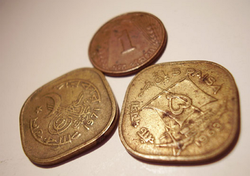How many coins are possible?
 Calvin put 2001 coins of 1, 2 or 3 dollars in a row. It turned out that between any two 1-dollar coins there is at least one coin; between any two 2-dollar coins there are at least two coins; and between any two 3-dollar coins there are at least 3 coins. There are
three dollar coins. How many values of
are possible?
Calvin put 2001 coins of 1, 2 or 3 dollars in a row. It turned out that between any two 1-dollar coins there is at least one coin; between any two 2-dollar coins there are at least two coins; and between any two 3-dollar coins there are at least 3 coins. There are
three dollar coins. How many values of
are possible?
Image Credit: Flickr Jamal Ashiqain .
The answer is 2.
This section requires Javascript.
You are seeing this because something didn't load right. We suggest you, (a) try
refreshing the page, (b) enabling javascript if it is disabled on your browser and,
finally, (c)
loading the
non-javascript version of this page
. We're sorry about the hassle.
Let a i be the value of the i -th coin in dollars. Thus { a i } i = 1 2 0 0 1 is a sequence of integers, where a i ∈ { 1 , 2 , 3 } , where if a i = a j then ∣ i − j ∣ ≥ a i + 1 .
Suppose i ≥ 4 and a i = 3 . Clearly a i − 1 = 3 . If a i − 1 = 2 , then a i − 2 = 1 is forced, and a i − 3 has no possible choice, contradiction. So a i − 1 = 1 . By symmetry, this also proves that if i ≤ 1 9 9 8 and a i = 3 , then a i + 1 = 1 .
Likewise, if 2 ≤ i ≤ 1 9 9 9 and a i = 2 , then a i − 1 = 1 (it can't be 2 for obvious reasons, and if it's 3 then we get the case above), and similarly if 3 ≤ i ≤ 2 0 0 0 and a i = 2 then a i + 1 = 1 .
These claims prove that for 4 ≤ i ≤ 1 9 9 8 , whenever there is a 2 or a 3 , both two adjacent numbers must be 1 's; that is, if a i = 1 , then a i − 1 = a i + 1 = 1 . Additionally, a i + 2 = 1 (collision with a i + 1 ) and a i + 2 = a i (because a i ≥ 2 ), so a i + 2 is forced ( 5 − a i ). If i + 2 ≤ 1 9 9 8 , this forces that a i + 3 = 1 and a i + 4 = a i , and so on.
Basically, the above proves that between 3 ≤ i ≤ 1 9 9 9 , the sequence a i is periodic, with the repeated part 1 , 2 , 1 , 3 , only with potentially different starting offset. This gives only four cases to consider:
Thus there are either 5 0 0 or 5 0 1 terms equal to 3 , so there are 2 such possibilities.